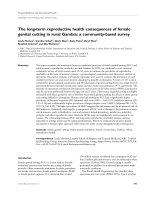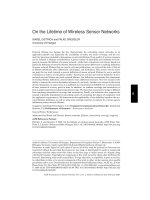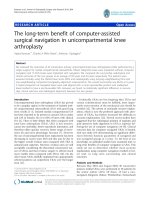On the long term wireless network deployment strategies
Bạn đang xem bản rút gọn của tài liệu. Xem và tải ngay bản đầy đủ của tài liệu tại đây (395.88 KB, 75 trang )
On the Long-term Wireless Network
Deployment Strategies
WU QI MING
NATIONAL UNIVERSITY OF SINGAPORE
2007
i
On the Long-term Wireless Network
Deployment Strategies
WU QI MING
(B.Eng, SHANGHAI JIAO TONG UNIVERSITY)
A THESIS SUBMITTED
FOR THE DEGREE OF MASTER OF ENGINEERING
DEPARTMENT OF ELECTRIC AND COMPUTER ENGINEERING
NATIONAL UNIVERSITY OF SINGAPORE
2007
ii
ACKNOWLEDGEMENTS
I wish to express my sincere gratitude to my supervisor, Dr. Chew Yong Huat,
who is from the Institute for Infocomm Research (I2R). Thanks for his invaluable
guidance, support, encouragement, patience, advice and comments throughout my
dissertation. His rigorous academic attitude has imbued a deep sense of value in me.
Without his help, I might not be able to complete this thesis. It is him who encouraged
me to complete my research using my after office hour when I was about to give up.
I also want to thank Dr. Yeo Boon Sain, who was previously also from I2R for
the encouragement and inspiration given to my research topic.
I also want to thank my wife, who is always by my side, supporting and
encouraging me to go through all the hard times.
Last but not least, I want to thank my parents. Their love and never ending
support are what I treasure the most.
iii
TABLE OF CONTENTS
Acknowledgements .....................................................................................................iii
Table of contents .........................................................................................................iv
List of notations ..........................................................................................................vii
List of Abbreviations ..................................................................................................ix
List of Figures..............................................................................................................xi
List of Tables..............................................................................................................xii
Summary ....................................................................................................................xiii
Chapter 1 ...................................................................................................................... 1
Introduction.................................................................................................................. 1
1.1.
Evolution of Mobile communications ............................................................ 1
1.2.
Problem introduction....................................................................................... 4
1.3.
Thesis motivation............................................................................................ 7
1.4.
Organization of the thesis .............................................................................10
Chapter 2 ....................................................................................................................12
Single -period Optimization.......................................................................................12
For FDMA-based Systems ........................................................................................12
Design Problem........................................................................................................13
(a)
Traffic demand in the service area.......................................................13
(b)
Candidate locations for APs.................................................................13
(c)
Propagation model...............................................................................13
iv
(d)
Cost and revenue ..................................................................................15
Problem formulation ................................................................................................15
Optimal Solution......................................................................................................19
Chapter 3 ....................................................................................................................23
Single -period Optimization For CSMA-based Systems .........................................23
3.1
Throughput of CSMA/CA based systems .....................................................23
3.2 The distance effect on throughput ......................................................................30
3.2
Design for a WiFi-like network ....................................................................33
3.3
Optimal solution over a period .....................................................................34
Chapter 4 ....................................................................................................................39
Optimization Model Considering Future Traffic ...................................................39
4.1 Formulation .....................................................................................................40
4.2 Reduce the number of feasible solutions ........................................................42
Observation 1..................................................................................................42
Observation 2: ................................................................................................44
Chapter 5 ....................................................................................................................47
Optimization Model With Probabilistic Future ......................................................47
5.1
Formulation with decision analysis ..............................................................48
5.2 Use of utility theory in decision making .........................................................52
Chapter 6 ....................................................................................................................55
Conclusions and Future Research ............................................................................55
6.1
Concluding remarks ......................................................................................55
v
6.2
Future research..............................................................................................57
Publication..................................................................................................................58
References...................................................................................................................59
vi
LIST OF NOTATIONS
γ
a factor to reserve some bandwidth in the APs
A
set of candidate sites
ai
whether AP i should be activated. a i = 0 if the ith AP is not
activated, a i = 1 if the AP is activated
B
channel capacity
CA
the hardware cost
Cc
the running cost of a channel
CI i
the initialization cost such as installation
cik
the assignment parameter indicates that channel k of AP i is
being activated
CMi
the maintenance cost of AP i and
Dij
the equivalent distance between AP i and DP j
f
the amount of attenuation (in dB) due to the presence of floors
in the propagation path
f i1i2
f i1i2 = 0 is used to indicate no interfere between APs i1 and
i2 , For f i1i 2 = 1 , the relationship ri1 + ri2 ≤ 2 Rmax gives no effect
i
candidate site index
j
demand point index
k
channel number
lp
number of feasible solutions for period p
vii
M
set of demand points
m
the number of walls
n
the number of floors
P
the utilization charge for per unit demand traffic
Rmax
the maximum coverage radius of an AP
ri
the equivalent coverage radius (i.e., attenuation due to the
presence of obstacles has been compensated by an additional
distance) of the AP for its transmission power
Tj
the demand traffic at DP j
tij
traffic from the ith AP to DP j
w
the amount of attenuation (in dB) due to the presence of walls in
the propagation path
xij
the assignment parameter denote the link between DP j and
candidate AP site i
viii
LIST OF ABBREVIATIONS
AMPL
Modeling Language for Mathematical Programming
AMPS
Advanced Mobile Phone System
ANSI
American National Standards Institute
AP
Access Point
BPSK
Binary Phase Shift Keying
BS
Base Station
CCK
Complementary code keying
CDMA
Code Division Multiple Access
CSMA/CA
Carrier Sense Multiple Access/Collision Avoidance
DCF
Distributed Coordination Function
DIFS
DCF Inter frame Space
DP
Demand Point
DSSS
Direct Sequence Spread Spectrum
FDMA
Frequency Division Multiply Access
GLPK
GNU Linear Programming Kit
GNU
GNU's Not Unix
GPL
General Public License
GSM
Global System for Mobile Communications
IEEE
Institute of Electrical and Electronics Engineers
ix
ILP
Integer Linear Programming
LAN
LocalAreaNetwork
MAC
Media Access Control
MAN
Metropolitan Area Network
MILP
Mixed Integer Linear Programming
NP-HARD
Nondeterministic Polynomial-time hard
OFDM
Orthogonal Frequency Division Multiplexing
PCF
Point coordination function
QAM
Quadrature amplitude modulation
QPSK
Quadrature phase -shift keying
RTS/CTS
Request-T o-Send/Clear-To-Send
SP
Service Provider
UDP
User Datagram Protocol
UMTS
Universal Mobile Telecommunications System
VPN
Virtual Private Network
WAN
Wide Area Network
WCDMA
Wideband Code Division Multiple Access
WEP
Wired Equivalent Privacy
WiFi
Wireless Fidelity
WLAN
Wireless Local Area Network
x
LIST OF FIGURES
Figure 1-1 Candidate points and demand points in a indoor environment .................... 8
Figure 1-2 New demand points in indoor environment ................................................. 9
Figure 1-3 A projected traffic demand (versus time) at a given AP ............................10
Figure 2-1 An example showing the traffic demand points (crosses) and candidate
access point sites(points) ..............................................................................................20
Figure 2-2 Optimal AP placements to support the given traffic demands...................22
Figure 3-1 Markov chain model for CSMA/CA..........................................................27
Figure 3-2 Data rate fall off for 802.11b as function of distance from AP for n = 2
......................................................................................................................................32
Figure 3-3 AP deployment without classes .................................................................37
Figure 3-4 Comparison between with and without rate adaptation .............................38
Figure 4-1 A modified branch-and-cut algorithm ........................................................44
Figure 5-1 Traffic demand in the 2 projected periods with probabilities ....................49
Figure 5-2 Evaluation of optimal solution for probabilistic traffic demand ................52
Figure 5-3 An utility function: u (R ) versus R .......................................................54
xi
LIST OF TABLES
Table 2.1 Typical value of attenuation for different obstacle ......................................15
Table 2.2 The initial costs for each candidate APs ( C I ).............................................20
Table 2.3 Demand traffic at each demand point ( T j ) ..................................................21
Table 3.1 Parameters that affects throughput...............................................................30
Table 4.1 Demand traffic at each demand point ( T j ) ..................................................45
Table 4.2 Demand traffic at each demand point ( T j ): Feasible solutions in Period 1
and 2 to be used for optimal search..............................................................................46
Table 5.1 Traffic demand M3 in the 2nd period..........................................................50
Table 5.2 Solutions for M3 in the 2nd period..............................................................50
Table 5.3 Possible optimal solutions given a solution of M1 (a) M2 (b) M3 (c)
weighted sum ...............................................................................................................51
Table 5.4 Utility values for various solution ...............................................................54
xii
SUMMARY
The deployment of wireless networks needs to consider both the cost and system
performance metrics. The design objective is to decide the optimal placement of
access points (or base stations) and to assign the available radio resources to
respective traffic demand points with guaranteed performance, while keeping the
deployment cost at its minimum. The optimization problem can become quite
complicated when multiple performanc e metrics need to be satisfied concurrently.
Most of the reported works formulate the problem using mixed integer linear
programming (MILP) but with different objective functions. Normally these works
assumed that demand traffic do not vary with time. However, we feel that it would be
better to adopt a design which can achieve long-term optimal rather than just at the
instant of deployment. In this thesis , we set up a platform to look into the deployment
of wireless networks which is able to optimize the profit generated over multiple
periods each with different spatial traffic demands. Given a set of candidate sites, we
first derive the placement and compute the transmission power of the access points to
support a given spatial traffic demand over a specific period of time. The problem was
also formulated using a mixed integer linear programming model, both for the FDMA
based and CSMA/CA based networks. Adjustable transmission range is made
possible through power control to minimize the amount of interference among
neighboring access points. With the knowledge on the projected demand traffic in
xiii
subsequent periods, algorithms to maximize the long term profit are developed, both
when the projected traffic are probabilistic and deterministic.
xiv
CHAPTER 1
INTRODUCTION
1.1. Evolution of Mobile communications
Wireless technology has been developed for more than a century since
Guglielmo Marconi invented the world’s first wireless telegraph in 1896. Today
wireless communication devices and technologies have penetrated our daily lives and
it will surely continue to be so in the next decade.
From 1896, wireless communication technologies have gone through various
evolutions. When communication satellites were first launched in the 1960s, those
satellites could only handle 240 voice circuits. Today, satellites carry about one -third
of the total voice traffic and all the television signals between countries. The cellular
or mobile telephones which are the modern equivalent of Marconi’s wireless
telegraph, can now offer very reliable two-party with two-way communication even
under high user mobility. The first–generation of wireless phones use d the analog
1
technology. The dominant first-generation digital wireless network in North America
was the Advanced Mobile Phone System (AMPS). The network devices were bulky
and coverage was patchy, but they successfully demonstrated the inherent
convenience to perform communications between two parties [1]. The current or
second-generation of wireless devices are using digital technology instead of analog.
The existing deployed second-generation wireless systems are the GSM [2], PCS
IS-136 and PCS IS-95. Cellular systems such as GSM are optimized for wide-area
coverage, and can provide bit rates around 200kbps in each carrier frequency. The
third-generation of cellular systems, also known as the Universal Mobile
Telecommunications Systems (UMTS [3]), aims to deliver data rates of 384 kbps for
high mobility users and up to 2 Mbps for low mobility users. The UMTS standard
was based on WCDMA technology. Another UMTS proposal is based on the
CDMA2000 by the United States, which is compatible with IS-95 CDMA.
With the booming use of Internet in the recent decades, users are demanding for
more bandwidth to transmit multimedia traffic . Service providers therefore have the
urge to develop wireless networ ks which can support higher data transmission rate in
order to meet the users’needs. Higher data rate systems are now achievable with the
development of broadband wireless technology. The two key factors to make wireless
services to a success and become popular are the convenience to access (i.e., good
coverage and reliable) and the low er development costs (i.e. cheap) . The low
development cost can be achieved now with today’s wireless technologies since
operators can provide the usual telecommunication services with low cost wireless
2
devices. The fact that service s are possible for high mobility users has provided us
with a convenient way of performing communications. Furthermore, standardization
is also necessary to ensure interoperability between devices developed by different
vendors. There are many initiatives in developing broadband wireless standards for
different applications, from the wireless LAN to the small wireless home network.
Their data rates vary from 2 Mbps to well over 100 Mbps. Many of these technologies
are available now and more will become available in the next several years. Among
these standards, Wi-Fi seems to get much more attention in the recent years. Wi-Fi
(IEEE 802.11) denotes a set of w ireless LAN/WLAN standards developed by the
working group 11 of the IEEE LAN/MAN Standards Committee (IEEE 802). The
term 802.11x is also used to denote the set of amendments to the standard.
The original version of the standard IEEE 802.11 [4] released in 1997 specifies
two raw data rates of 1 and 2 megabits per second (Mbps) to be transmitted via
infrared (IR) signals or by either frequency hopping or direct-sequence spread
spectrum in the Industrial Scientific Medical (ISM) frequency band at 2.4 GHz. The
802.11a amendment to the original standard was ratified in 1999. The 802.11a
standard uses the same core protocol as the original standard, operates in 5 GHz band,
and uses a 52-subcarrier OFDM with a maximum raw data rate of 54 Mbps, which
yields realistic net achievable throughput in the mid-20 Mbps. The data rate can be
reduced to 48, 36, 24, 18, 12, 9 then 6 Mbps if required. The 802.11b amendment to
the original standard was ratified in 1999. 802.11b has a maximum raw data rate of 11
Mbps and uses the same CSMA/CA media access method defined in the original
3
standard. Due to the CSMA/CA protocol overhead, in practice the maximum 802.11b
throughput that an application can achieve is about 5.9 Mbps using TCP and 7.1 Mbps
using UDP. IEEE 802.11g was the third modulation standard for Wireless LAN. It
operates at a maximum raw data rate of 54 Mbps , or about 19 Mbps net throughputs
(identical to 802.11a core, except for some additional legacy overhead for backward
compatibility). The modulation scheme used in 802.11g is OFDM at the data rates of
6, 9, 12, 18, 24, 36, 48, and 54 Mbps.
1.2. Problem introduction
Of all the technologies which enabling the tremendous advances in data and
voice communications, perhaps the most revolutionary is the development of cellular
concept [5]. The use of cellular technology overcomes the capacity bottleneck when a
limited spectrum is used for transmission – it provides system capacity expansion
through the reuse of frequency over the geographical space. In cellular networks such
as GSM, the service area is divided into many regions known as “cells”. Each cell is
allocated with a few frequencies and is served by a base station which consists of
transmitter s, receivers and a control unit. Adjacent cells are assigned with different
frequencies to avoid interference or crosstalk. However, cells which are sufficiently
separated can reuse the same frequency band for transmission. Other key methods
used to improve the design of cellular networks are cell splitting, cell sectoring and
the use of micro-cells, etc.
4
Wireless LANs pr ovide mobility through roaming capabilities. However,
because of the difference in multiple access signaling techniques used, deploying a
wireless network is not simply a matter of identifying user locations and connecting
them to the backbone. The deployment of each wireless system is unique in many
aspects, and careful planning and a meticulous site survey are required. In the
literature, the deployment of wireless networks involves the search for the base
stations (BS) (or access points (APs)) placement while maximizing the profit or
minimizing the cost has been studied. For this thesis, we narrow down our discussions
to AP placement. However, the approach can be applied equally well to cellular
systems. Normally, to minimize the cost, service providers (SPs) select the least
number of APs to support the demand traffic , by taking both the multiple access and
signaling techniques into consideration.
The solution to select a subset of candidate AP locations which is the least in
number but yet able to cover all traffic demand points (DPs) is a combinatorial
optimization problem – the well known minimum cardinality set covering problem [6].
The problem is NP-hard and heuristic approaches are usually used to obtain the
suboptimal solutions. In [7], a computer-based tool which allows one to measure the
AP coverage is developed. In [8], an efficient heuristic approach using a combined
greedy and local search algorithm to reduce the computation time is reported. In [9], a
framework based on simulated annealing is used for BS site selection. Rodrigues [ 10]
gave out a mixed integer programming model to solve the wireless network
deployment problem. Their objective is to maximize the sum of received signal power
5
of all the mobile stations in the network. They also started to solve this problem using
a commercial linear programming tool — CPLEX. Lee [11] proposed a MILP model
to solve the deployment problem. The ir optimization objective is to minimize the
maximum channel utilization, which qualitatively is as indication of the user of
congestion at the hottest spot in the WLAN service areas. In this paper, a method to
dynamically adjust the configuration of the network to achieve its objective was
mentioned. In [12], a method for finding optimal base stations configuration for
CDMA systems jointly with uplink and downlink constraints was proposed using the
approach.
In addition, the optimization problem can become quite complicated when
multiple performanc e metrics need to be satisfied concurrently. Most of the reported
works formulate the problem using mixed integer linear programming (MILP) but
with different objective functions. In [8], the effect of interference was considered and
results in a quadratic set covering problem. In [9], the objective function is to
maximize the total received signal level of all the traffic DPs. In [10], the authors
proposed an approach of optimizing AP placement to maximize the radio resource
utilization. Normally these works assumed that the demand traffic does not vary with
time. An exception is in [12], an integer linear programming (ILP) model is proposed
and during the optimization process, the SP needs to observe the traffic demand over
different periods of a day to obtain a better decision on AP sites.
6
1.3. Thesis motivation
The use of MILP model to solve such network deployment problems has been
widely adopted. However, to my best knowledge, there is no effort to look into the
deployment when multi-period optimization is of concern. If the business plan of SP
is to look at return of investment, the placement of APs should adopt an intermittent
approach: to match with the predicted future demand traffic over different periods of
time rather than one solution for all. For example, as shown in Figure 1-1, in an
indoor environment, a wireless network is to be deployed. There are totally 3 possible
candidate AP loc ations which are labeled as A, B, and C. There are also 3 demand
points which are labeled as 1,2 and 3. The cost of mounting an AP on location A,B
and C are 10, 15 and 20 dollars separately due to different position and cable wiring.
The circle around each candidate points indicates the effective transmission range of
an AP if it is mounted on this point. In this picture, obviously, candidate A should be
selected because the cost is the lowest (20 dollars) and all the demand points can be
covered. However, if after some time, there are new demand points appear to be
served, the planner will have to reconsider the problem. As is shown in Figure 1-2,
there are 2 new demand points---demand points 4 and 5. The AP mounted on location
A cannot cover demand point 4 and 5. In this new scenario, an AP has to be mounted
on candidate point C so that demand point 4 and 5 can be covered. Besides, once AP
in C location is mounted, the AP in location A should be removed to reduce
unnecessary cost. However, even if AP in location A is removed, some relevant cost
such as mounting cost and wiring cost has already occurred in location A. If the AP
7
can be reused, the total cost of mounting and wiring is the sum of mounting cost in A
and C ( 30 dollars). What if we mount the AP in location C in the first place? The total
cost should be 20 dollars only. So the optimal solution in one stage may not be the
overall optimal solution over multiple time periods. If we can anticipate the future
demand point location, maybe there is a way for us to improve the deployment plan.
Figure 1-1 Candidate points and demand points in a indoor environment
8
Figure 1-2 New demand points in indoor environment
This scenario is not rare in the real life, especially when certain network service
is just taking off, the initial traffic can be low in each DP. As time goes by, the traffic
in each DP will increase due to the acceptance of the technology by users. After some
time, due to market saturation, the demand may maintain at a certain level. Figure 1-3
shows the change of the number of demand points in certain service area in different
months. Because of this reason, service providers will need to find a solution to get as
much profit as possible while keeping the customer satisfied with the service. The
challenge is in the uncertainty of the future. This thesis developed a decision analysis
model to solve this problem. This thesis also developed a probabilistic model for the
scenario in indeterminate future.
9
Figure 1-3 A projected traffic demand (versus time) at a given AP
1.4. Organization of the thesis
This thesis uses the method of operational research to deal with the network
optimization. Our unique contribution is that optimization is performed over a longer
time frame which includes the future projected traffic , hence, the solution may not
necessary be optimized at the instant of the design.
In Chapter 2 and 3, two networks deploying different multiple access schemes
are studied. Chapter 2 focuses on the FDMA system and Chapter 3 focuses on a
WiFi-like system which deployed CSMA/CA. In Chapter 3, the effect of CSMA/CA
protocol on the achievable throughput is discussed in detail. The estimation of the
throughput is presented before brought into the integer programming model. Rate
10
adaptation is also taken care in the model for the WiFi-like network. Chapter 4
focuses on the optimization over multiple periods for the wireless network. A
branch-and-cut algorithm is introduced to improve the calculation speed. In C hapter 5,
the decision analysis theory is used to deal with the uncertain future demand. Utility
theory is also used when we try to adapt the different strategies to different users.
Chapter 6 gives out the concluding remarks and directions for future research.
11









